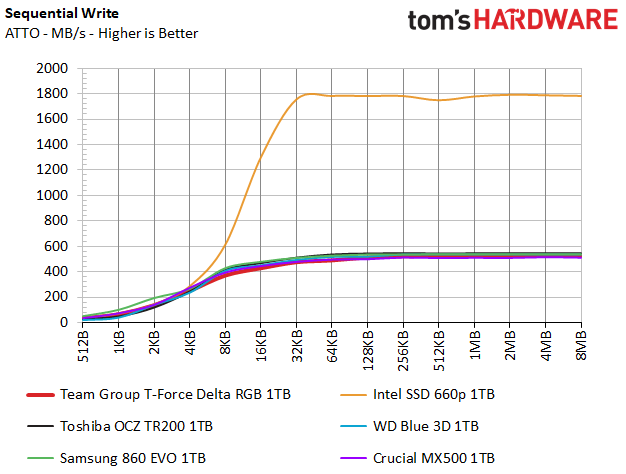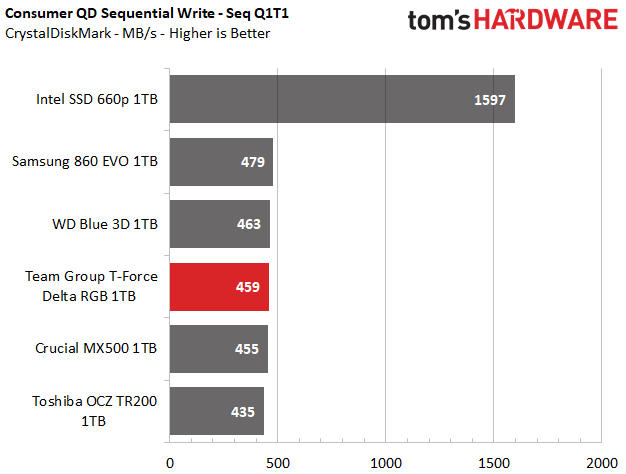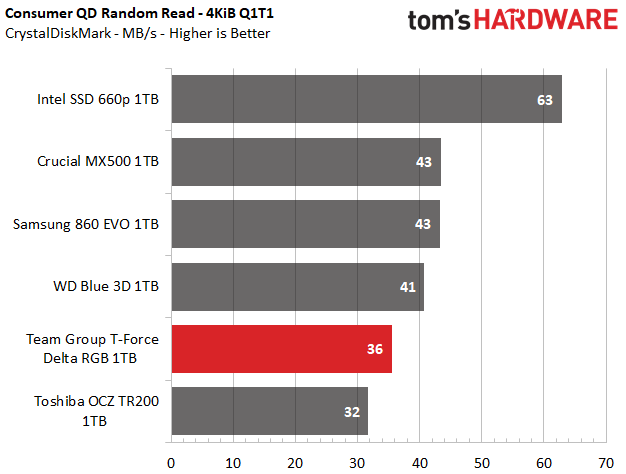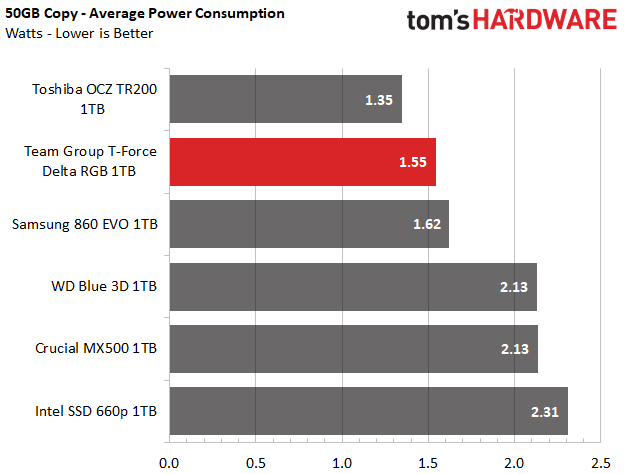Team Group T-Force Delta RGB SSD Review: RGB SSD Done Right, Kinda
Why you can trust Tom's Hardware
1TB Performance Results
Trace Testing – PCMark 8 Storage Test 2.0
PCMark 8 is a trace-based benchmark that uses Microsoft Office, Adobe Creative Suite, World of Warcraft, and Battlefield 3 to measure the performance of storage devices in real-world scenarios.


The 1TB Delta delivers a notable improvement over the smaller 250GB model, but it isn't enough to take the crown. Instead, the drive ranks 5th overall, closely behind Crucial’s MX500.
Game Scene Loading - Final Fantasy XIV
The Final Fantasy XIV StormBlood benchmark is a free real-world game benchmark that easily and accurately compares game load times without the inaccuracy of using a stopwatch.
The 1TB Delta RGB was actually loads game scenes slower than the 250GB model. Here it loaded the scenes in 23.1 seconds, which ranks ahead of both the TR200 and WD Blue 3D.
Transfer Rates – DiskBench
We use the DiskBench storage benchmarking tool to test file transfer performance with our own custom 50GB block of data. Our data set includes 31,227 files of various types, like pictures, PDFs, and videos. We copy the files to a new folder and then follow up with a read test of a newly-written 6 GB file.


The NVMe-based Intel SSD 660p teases its SATA competitors with an average of 291MB/s. But the Delta’s results are very similar to the Crucial MX500 and WD Blue 3D. The Delta RGB performs three times faster than an HDD and almost twice as fast as Toshiba’s OCZ TR200 during our file copy test.
SYSmark 2014 SE
Like PCMark, SYSmark uses real applications to measure system performance. SYSmark takes things much further, however. It utilizes fourteen different applications to run real workloads with real data sets to measure how overall system performance impacts the user experience.
Get Tom's Hardware's best news and in-depth reviews, straight to your inbox.
BAPCo's SYSmark 2014 SE installs a full suite of applications for its tests, which includes Microsoft Office, Google Chrome, Corel WinZip, several Adobe software applications, and GIMP. That also makes it a great test to measure the amount of time it takes to install widely-used programs after you install a fresh operating system.


The Team Group T-Force Delta RGB installs SYSmark faster than any other SATA device in our comparison pool. This lead is short-lived, however. The Delta RGB ranks sixth place in the responsiveness score, just a few points below the Samsung 860 EVO and WD Blue.
ATTO
ATTO is a simple and free application that SSD vendors commonly use to assign sequential performance specifications to their products. It also gives us insight into how the device handles different file sizes.




Like the 250GB model, the 1TB model lands the lower portion of the chart but still delivers speeds of 560/525MB/s read/write. While a bit more than just a few bucks more at the 1TB capacity, the Intel SSD 660p clearly takes the lead when it comes to sequential workloads–it's over three times faster.
Anvil's Storage Utilities
Anvil's Storage Utility is a commonly-referenced benchmark that simplifies the complex IOMETER benchmark and its underlying Dynamo engine with a one-click software wrapper.



The Delta takes fifth place due to its lower than average read and write scores. We really see the weakness of the TR200's DRAMless architecture in the write performance results, but that type of workload is the Delta RGB's strength.
CrystalDiskMark
CrystalDiskMark (CDM) is a simple and easy to use file size benchmarking tool.










The Intel 660p takes the lead in sequential performance at QD32. The Delta RGB, however, delivers a respectable result of 562/526MB/s read/write. Unlike the 250GB capacity, the 1TB model delivered similar 4K results at queue depth 32 compared to the rest of the drives.
The Delta scores an average result at QD1, but, like in Anvil, the Delta is more competitive during write workloads than it is during reading tasks.
Sustained Sequential Write Performance
Official write specifications are only part of the performance picture. Most SSD makers implement an SLC cache buffer, which is a fast area of SLC-programmed flash that absorbs incoming data. Sustained write speeds can suffer tremendously once the workload spills outside of the SLC cache and into the "native" TLC or QLC flash. We hammer the SSDs with sequential writes for 15 minutes to measure both the size of the SLC buffer and performance after the buffer is saturated.


The 660p offers three to four times the write performance but slows down to just over 100MB/s after 135GB of data writes. Like the 250GB model, the 1TB Team Group Delta RGB slows down after being written to for more than a few seconds. After writing 11GB of data at a rate of 525MB/s, our 1TB sample’s write performance degraded to 470MB/s for the remainder of the test. Compared to the Samsung, WD, and Crucial comparison products, it’s a small difference.
Power Consumption
We use the Quarch HD Programmable Power Module to gain a deeper understanding of power characteristics. Idle power consumption is a very important aspect to consider, especially if you're looking for a new drive for your laptop. Some SSDs can consume watts of power at idle while better-suited ones sip just milliwatts. Average workload power consumption and max consumption are two other aspects of power consumption, but performance-per-watt is more important. A drive might consume more power during any given workload, but accomplishing a task faster allows the drive to drop into an idle state faster, which ultimately saves power.





We were surprised to see how closely the 1TB results were to the 250GB model. With an average of 1.55W, along with a maximum of 2.68W recorded during the 50GB copy test, the Delta RGB has very low power requirements under load. The Delta is also very efficient at 97MB/s per watt. The Samsung 860 EVO’s 108MB/s per watt and the NVMe Intel 660p’s 120MB/s per watt are better, though.
The drive sipped 0.366W of power at idle with LPM disabled. But while we were hoping to see an improvement with LPM enabled, unlike other SSDs we've tested, the Delta RGB wouldn’t drop into a lower power mode. Thus, its 0.366W lands in last place.
MORE: Best SSDs
MORE: How We Test HDDs And SSDs
MORE: All SSD Content

Sean is a Contributing Editor at Tom’s Hardware US, covering storage hardware.
